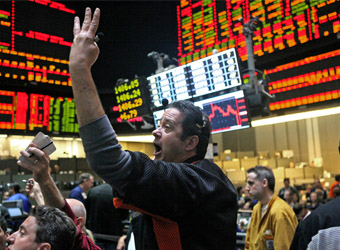U.S. stocks fell on Monday, but closed well off their lows, while investors digested key economic and auto sales data.
“The negative narrative today was disjointed and loose,” said Art Hogan, chief market strategist at Wunderlich Securities. “It’s hard to take out this market when the fundamentals are so strong.
The Dow Jones industrial average closed about 10 points lower, with DuPont and Goldman Sachs contributing the most losses. The 30-stock index briefly fell more than 100 points earlier in the session.
“Investors continue to look for strong economic data as we try to rely less on the government, especially in a world where the Fed is tightening and the Trump policies haven’t come through yet,” said Jack Ablin, chief investment officer at BMO Private Bank.
The S&P 500 dropped 0.2 percent, with materials and consumer discretionary lagging. The Nasdaq composite hit a new all-time intraday before sliding 0.3 percent.
The ISM manufacturing index read for March hit 57.2, topping estimates but slipping from the previous month’s level. Construction spending rose 0.8 percent in February to its highest level in nearly 11 years.
Monthly auto sales numbers were released throughout the day, with Ford, General Motors and Fiat Chrysler all reported declining numbers. Sales totaled 16.62 million for March, according to Autodata.
U.S. Treasurys bounced following the data releases, with the benchmark 10-year note yield falling to 2.33 percent and the two-year note yield slipping to 1.23 percent.
“The Treasury market is getting a bit of a bounce because the data has begun to slow a bit, at least on a month-to-month basis,” said Craig Bishop, vice president of U.S. fixed income at RBC Wealth Management.
Other data set for release this week include minutes from the Federal Reserve’s previous meeting and March’s jobs report.
“A lot of focus will be towards some key economic numbers that can very much set the tone for the trading action of this week,” said Naeem Aslam, chief market strategist at Think Markets.
Wall Street also prepared itself for a meeting between President Donald Trump and Chinese President Xi Jinping on Thursday and Friday. The two leaders are expected to discuss trade and North Korea, among other subjects.
Lukman Otunuga, research analyst at FXTM, said the two-day meeting may be classified as an event risk.
“Any complications or tension in the meeting could spark risk aversion consequently pressuring stock markets while boosting attraction for safe-haven assets,” he said.
Stocks closed off a strong first quarter on Friday, with the major indexes posting gains of at least 4.56 percent. That said, the rally stalled last month amid uncertainty about when the Trump administration’s pro-growth policies grew.
“The market has been locked into this trading range,” said Bruce Bittles, chief investment strategist at Baird. “There’s just a loss in upside momentum and I think that’s going to continue into the earnings season.”
Earnings season is around the corner and Wall Street largely expects solid profit growth, especially in the energy sector.
“With almost half of earnings growth expected to come from energy, if oil prices don’t stabilize and start to rise, that could be a problem,” said Nick Raich, CEO of The Earnings Scout.
U.S. crude fell 0.7 percent to settle at $50.24 per barrel. Last month, oil prices dropped 6.3 percent.
The dollar rose 0.2 percent against a basket of currencies, with the euro near $1.067 and the yen around 111.
Overseas, European equities declined, with the Stoxx 600 index falling 0.49 percent. In Asia, stocks rose broadly, as the Nikkei 225, Shanghai composite, Hang Seng index and Kospi all closed higher.
The Dow Jones industrial average fell 13.01 points, or 0.06 percent, to close at 20,650.21, with DuPont leading decliners and UnitedHealth outperforming.
The S&P 500 dropped 3.88 points, or 0.16 percent, to end at 2,358.84, with consumer discretionary leading seven sectors lower and telecommunications leading.
The Nasdaq declined 17.06 points, or 0.29 percent, to close at 5,894.68.
About four stocks declined for every three advancers at the New York Stock Exchange, with an exchange volume of 924.74 million and a composite volume of 3.408 billion at the close.
The CBOE Volatility Index (VIX), widely considered the best gauge of fear in the market, traded near 12.3.
Monday
Monthly vehicle sales
Tuesday
8:30 a.m. Trade deficit
10:00 a.m. Factory orders
4:30 p.m. Fed Gov. Daniel Tarullo
Wednesday
8:15 a.m. ADP payrolls
9:45 a.m. Services PMI
10:00 a.m. ISM non-manufacturing
2:00 p.m. Fed minutes
Thursday
8:30 a.m. Jobless claims
Friday
8:30 a.m. Employment report
10:00 a.m. Wholesale trade
12:15 p.m. New York Fed’s Dudley speaks on financial regulation
3:00 p.m. Consumer credit
